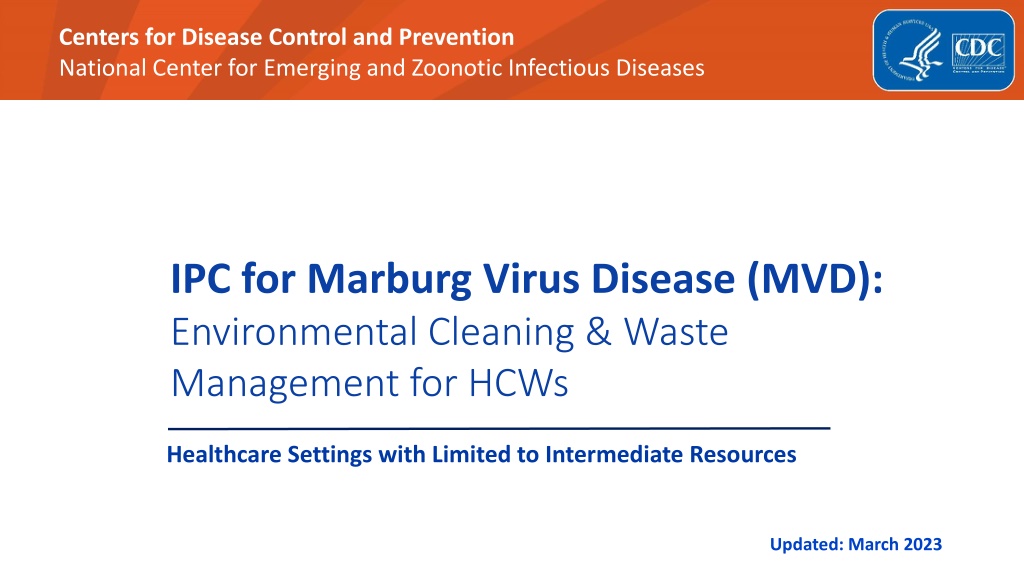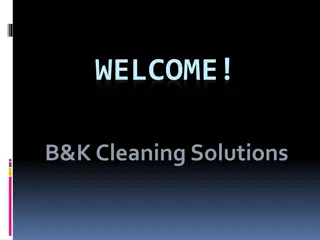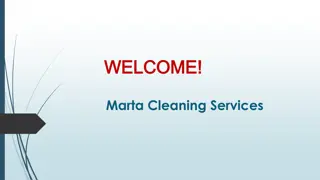Environmental Cleaning for Marburg Virus Disease: Importance and Guidelines
Environmental cleaning is crucial in preventing the spread of Marburg virus disease. This presentation emphasizes the significance of proper cleaning practices, detailing key principles and waste management strategies. It outlines the importance of cleaning before disinfecting, using appropriate personal protective equipment, and dedicating cleaning supplies for high-risk areas. The content highlights the dangers of contaminated surfaces and equipment, stressing the role of cleaning in protecting healthcare workers, patients, and communities.
Download Presentation

Please find below an Image/Link to download the presentation.
The content on the website is provided AS IS for your information and personal use only. It may not be sold, licensed, or shared on other websites without obtaining consent from the author. Download presentation by click this link. If you encounter any issues during the download, it is possible that the publisher has removed the file from their server.
E N D
Presentation Transcript
Centers for Disease Control and Prevention National Center for Emerging and Zoonotic Infectious Diseases IPC for Marburg Virus Disease (MVD): Environmental Cleaning & Waste Management for HCWs Healthcare Settings with Limited to Intermediate Resources Updated: March 2023
Learning Objectives Learning Objectives After this presentation, participants will be able to Explain why environmental cleaning is important in the context of Marburg virus disease. Describe at least three general principles of environmental cleaning. Describe 3 common streams for waste in healthcare facilities.
Environmental Cleaning Overview Environmental Cleaning Overview
Why Environmental Cleaning? Why Environmental Cleaning? Marburg virus can live/persist on surfaces (tables, chairs, etc.) Touching contaminated surfaces or using contaminated equipment can spread Marburg virus to you and your patients. Appropriate cleaning and disinfection helps prevent the spread of Marburg virus disease in facilities. This protects YOU Your co-workers & patients Your community
Definition: Environmental Cleaning Definition: Environmental Cleaning Environmental cleaning is the general term for cleaning and disinfecting the patient care environment. Cleaning: removes dirt and some germs and is performed with soap and water Disinfecting: kills germs using chemicals such as 0.5% chlorine solution.
Principles of Environmental Cleaning Principles of Environmental Cleaning Always clean before disinfecting Organic material left on surfaces decreases effectiveness of disinfectants Always proceed from the cleanest area to the dirtiest area Isolation area should always be cleaned last Always clean in a systematic manner (e.g., clockwise) to avoid missing areas Always be sure to clean and disinfect patient care equipment between each patient Where possible, dedicate cleaning supplies in higher risk areas (e.g., delivery, operation room) Always dedicate cleaning supplies for Marburg virus disease isolation areas
PPE for Marburg Virus Disease Environmental Cleaning PPE for Marburg Virus Disease Environmental Cleaning Inner gloves (to assist when removing PPE) Outer gloves (thick, rubber gloves given use of chemicals while cleaning and disinfecting) Gown or coverall Apron Mucous membrane protection (*face mask + face shield) OR (*face mask + goggles) Rubber boots (or shoe covers) Head cover *Respirator can be used in place of face mask (structure of respirator keeps it from collapsing when soaked with sweat; may be preferred in hot, humid climates)
How to Clean Up a Spill of Body Fluids How to Clean Up a Spill of Body Fluids DO NOT spray disinfectant directly on body fluid spills 1. Perform hand hygiene 2. Put on appropriate PPE for the task 3. Use a cloth or absorbent towel to remove excess liquid 4. Clean surface with soap and water 5. Disinfect with 0.5% chlorine solution 6. After 15 minutes, let the surface dry 7. Discard waste and remove PPE 8. Perform hand hygiene
Using Chlorinated Solutions Using Chlorinated Solutions Use chlorine solution for environmental cleaning in Marburg virus disease isolation areas 0.05% for soft surfaces / porous items (bed sheets, cloth gowns) Soak for 30 minutes 0.5%* for hard/non-porous surfaces (floors, counters, bed rails) Make sure it stays wet on the surface for 15 minutes Do NOT spray chlorine Never spray people For surfaces, wiping is preferred https://www.mercycorps.org/blog/ebola-outbreaks-africa-guide/chapter-3 * Alternatives: Alcohol at 70-90% (ethanol, isopropyl), improved hydrogen peroxide 0.5%
Chlorine Chlorine A Word of Caution A Word of Caution Adverse health effects Respiratory problems Burns Potentially explosive when mixed Calcium hypochlorite + sodium dichloroisocyanurate = potential explosion Potential for creating toxic gases when mixed with ammonia or other cleaning products Eye, nose, and throat irritation and other severe reactions Chlorine burn from dunking hands with gloves on in bucket unknown concentration in bucket (Sierra Leone 2014 Ebola Virus Disease outbreak)
Which is correct? Cleaning is killing germs. Disinfecting is removing dirt and some germs. Disinfecting is a type of cleaning (cleaning with chemicals). Cleaning is a type of disinfecting (disinfecting with soap or detergent. Cleaning is removing dirt and some germs. Disinfecting is killing germs.
Answer Answer: : Cleaning is killing germs. Disinfecting is removing dirt and some germs. Disinfecting is a type of cleaning (cleaning with chemicals). Cleaning is a type of disinfecting (disinfecting with soap or detergent. Cleaning is removing dirt and some germs. Disinfecting is killing germs.
Waste Management Waste Management
Waste management includes: Waste management includes: storing waste treating waste disposing of waste sorting/segregating waste collecting waste transporting waste Safe management of waste generated during patient care is the responsibility of all staff.
Why Waste Management? Why Waste Management? Healthcare facilities are responsible for managing waste. Inappropriate waste management poses potential health risks toyou, your patients, and your co-workers, as well as to your community.
Waste Segregation Waste Segregation (1) (1) 3-bin system (most common) Other waste streams (less common) https://www.washinhcf.org/resource /wash-fit-training-package/
Waste Segregation Waste Segregation (2) (2) 3-bin system (most common) Other waste streams (less common) https://www.washinhcf.org/resource /wash-fit-training-package/
Waste Segregation Waste Segregation (3) (3) 3-bin system (most common) Other waste streams (less common) https://www.washinhcf.org/resource /wash-fit-training-package/
Waste Segregation Waste Segregation (4) (4) 3-bin system (most common) Other waste streams (less common) https://www.washinhcf.org/resource /wash-fit-training-package/
Waste Segregation Waste Segregation (5) (5) 3-bin system (most common) Other waste streams (less common) https://www.washinhcf.org/resource /wash-fit-training-package/
Collect Collecting ing and and T Transport ransporting ing W Waste aste Waste bags should be collected on a regular schedule or when bin is 2/3 full Wear appropriate PPE (heavy duty gloves, gown or coveralls, face mask, eye protection, foot covers or boots) when handling contaminated waste Transport the waste in a cart or wheelbarrow from place of segregation to place of storage or disposal Follow a designated transportation route
Waste Disposal Waste Disposal Healthcare facilities must have a functional system for the final disposal of waste Infectious and potentially infectious waste must be: Incinerated OR Treated with a non-burn treatment (autoclaving/grinding or other alternative treatment) before being placed in regular waste stream OR Buried
Reflection Reflection Based on what you learned today, will you do anything differently when performing environmental cleaning or disposing of waste in your healthcare facility?
Key Takeaways Key Takeaways Because Marburg virus disease can live on surfaces, it s important to keep the healthcare environment clean and dispose of waste properly to keep yourself, your co-workers and patients, and your community safe. You should always clean before disinfecting to remove organic material left on surfaces that can prevent disinfectants from working well. All facility employees play a role in waste management. Always dispose of waste in the proper bin.
Thank you! For more information, contact CDC 1-800-CDC-INFO (232-4636) TTY: 1-888-232-6348 www.cdc.gov The findings and conclusions in this report are those of the authors and do not necessarily represent the official position of the Centers for Disease Control and Prevention.























